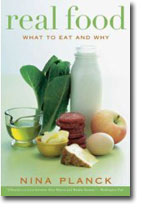Books |
Real Food: What to Eat and Why
Nina Planck
By
Published: Jul 12, 2017
Category:
Food and Wine
Her father was a college professor in upstate New York. Her mother started a school. But in the 1970s, Nina Planck’s parents bought 60 acres in Virginia and, with their three children, started a new life — as farmers.
The Plancks made a living selling produce at roadside stands and farmer’s markets. Their children were forced to eat real food. Without restraint: “My mother used to dip her toast in the bacon fat. Nothing was off limits except white sugar and white flour.”
The Planck kids grew up healthy and strong. But in her teens, Nina became a vegan. She had been 5’5” and 120 pounds, “most of it muscle.” Now she ran three to six miles a day — and bloomed to 147 pounds, with less muscle tone. Alarmed, she started responding to her natural hungers. And she learned two things:
1) “The more meat, fish, butter and eggs I ate, the better I felt.”
2) “No traditional culture is vegan — humans are omnivores.” Nature created humans as omnivores? Well, look in the mirror, she says: “We have the physical equipment for omnivory, from teeth to guts. We have extraordinary needs for nutrients not found in plants. They include fully-formed vitamins A and D, vitamin B12, and the long-chain fatty acids found in fish.”
Omnivores. Hmm. That should ring a bell if you’ve read Michael Pollan’s The Omnivore’s Dilemma or In Defense of Food. Planck’s book is a companion to Pollan, a hands-on guide to what you ought to eat, and why. [To buy “Real Food” from Amazon, click here. For the Kindle edition, click here. To read about the “Real Food Cookbook” on HeadButler.com, click here.]
Planck’s major proposition is that “traditional” food — “foods we’ve been eating for a long time” — is good for us. “Industrial” food — “recent and synthetic” — is bad for us. Worse, industrial food leads to the diseases of the industrial era: obesity, diabetes, heart disease. “The greatest error of modern industrial life, which celebrates the lab and technology, is our love affair with the facsimile,” she writes. “It is time to face the music. Some things cannot be replaced. Real food is one.”
Egg-white omelets? Skinless chicken breasts? Farmed fish? Not on her table. Above all: avoid corn in all its forms: corn-fed beef, corn oil, and corn syrup. “You’d be surprised at how much junk food you’ll stop eating,” she says.
You want to eat the skin of a roast chicken? Please do. Like mashed potatoes moistened with butter and milk? Go right ahead. And, yes, eat meat: “Plant protein is always inferior to animal protein.”
Some of this will be familiar — there are echoes here of the Mediterranean diet. What was new to me is the unwavering emphasis on natural foods in their purest form: grass-fed beef, whole milk from pastured cows, raw milk yogurts and cheeses. And on cooking combinations, foods that work together to release more useful energy in your body.
Planck has done massive homework, and the book is clotted with science — her conclusions aren’t just the pet theories of some New Age Whole Foods crowd. smarties will read pen in hand to mark the good stuff.
But then, you should read “Real Food” as if you’re going to school — there are that many pointers to better living here. Like which “organic” foods to eat. Unless you have unlimited wealth, you’ll notice your food bills are dramatically higher if you opt for an all-natural kitchen. If you have to choose, Planck says, it’s better to buy grocery vegetables and wash the chemicals off. Save your money for organic, grass-feed beef — if there are pesticides in animal protein, they’re in the most concentrated form. Not healthy.
And there are charming factoids along the way. My favorite: “spring” butter, so named because it’s produced by cows eating lush pasture in spring and fall. Priests used to bless it. If I could find some and slather it on real bread, I imagine I might too.
Inspired by this book, I went down to Murray’s Cheese Shop in Greenwich Village and bought a sampling of raw milk cheeses and yogurt. The yogurt had creamy lumps that made me think twice — until I had some. So that’s what yogurt tastes like! Ditto the cheeses, all of them much stronger than what we usually get.
Thanks to Pollard and Planck, we have banished most of the products that our fellow citizens enthusiastically swallow. Reality awaits.
To buy the Euro Cuisine YM80 Yogurt Maker from Amazon.com, click here.


